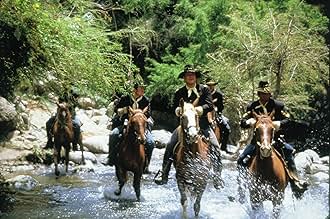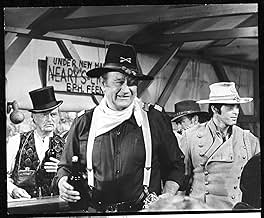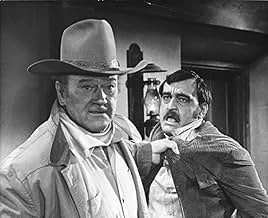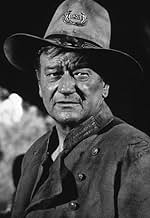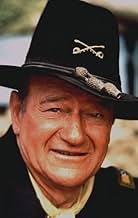AVALIAÇÃO DA IMDb
6,7/10
15 mil
SUA AVALIAÇÃO
Após a Guerra Civil, Cord McNally procura o traidor cuja traição levou à derrota de sua unidade guerreira e à perda de um amigo próximo.Após a Guerra Civil, Cord McNally procura o traidor cuja traição levou à derrota de sua unidade guerreira e à perda de um amigo próximo.Após a Guerra Civil, Cord McNally procura o traidor cuja traição levou à derrota de sua unidade guerreira e à perda de um amigo próximo.
- Direção
- Roteiristas
- Artistas
Avaliações em destaque
When I decided to write a review of Rio Lobo, I had every expectation of visiting the website and finding that the movie's weighted average was a 2.5. I was pleasantly surprised to see that it's a 7.5, and that's actually a half-point higher than my own score. To cut to the chase: I liked Rio Lobo.
It was fashionable in 1970 to trash Rio Lobo because (a) it was the supposedly feeble, last effort of a great director, Howard Hawks, who had supposedly lost interest in the picture; (b) it was too derivative of Rio Bravo and El Dorado; (c) the Duke was too old to play the part of a cavalry colonel (to say nothing of being too big; the average cavalryman in the Civil War was 5'7" and 135 lbs.); (d) the supporting cast was pathetic; (e) the production values were poor; and (f) the movie paled in comparison to Little Big Man, which was released at the same time. Much of the criticism was true. But, it was fun to watch, anyway.
Ford had his cavalry trilogy, and Hawks had his Rio trilogy, and the Duke was in all six of them. The Ford set is a cut above the Hawks set, but all six films are worth watching. Ford was working with Wayne (1947-50) at a time when Wayne's acting ability was still very much in question. And Ford succeeded on every level, especially in She Wore a Yellow Ribbon, where the character development of Capt. Nathan Brittles (Wayne) is nothing but sheer genius. Hawks, on the other hand, had (by 1959, in Rio Bravo) a very established star, and was thereby free to dwell more on story telling than he was on character development. Besides, with those amazing exteriors, the cinemagography alone was worth the cost of admission to all six pictures.
The Duke was too old to play a romantic lead in this picture (but so was Cary Grant in his last picture, Walk, Don't Run, when he, too, was about 63 years-old.) The fact that he was not a "threat" to O'Neill's character (in those pre-Viagra days) was nothing more than an extension of the persona the Duke captured the year before in True Grit, and would continue to build on in such films as The Cowboys and The Shootist. Let's face it: Wayne was becoming a likeable old coot.
Hawks was, according to reports, disappointed in Jennifer O'Neill, and by the last reel, her part has been cut in favor of Sherry Lansing's part. (Hawks did the same thing to John Ireland's part in Red River, 30 years earlier.) Actually, O'Neill didn't do THAT bad. My problem with her is that she couldn't decide whether she would play her part as the New York high-fashion model that she was, or as Kim Darby reprising her role in True Grit. At times, O'Neill's semi-imitation of Darby gets on one's nerves.
And, Hawks was rightfully disappointed in the desultory performances of the supporting cast, with the exception of Lansing and Jack Elam. The Confederate cavalry captain: He might as well have been created by computer graphics, for all the vitality he brings to the role. But, take a look at the stock players, including Hank Worden ("Old Mose" in The Searchers) and Jim Davis (Jock Ewing of Dallas fame). These are virtually cameos, if not walk-on parts, but they are effective.
I do not think Hawks gave up on this film, at least, not to the extent that people have claimed. Yakima Canutt ably handled the second unit, and the train hijacking he directed (with Hawks' help) was unusual and exciting; the cinematography, but for the occasional lighting or filtering error, was acceptable; and the editing was fairly crisp. The interior sets were shabby, that is true.
But what carries the picture is the wonderful dialogue, and Wayne. The dialogue is "pure Hawks": spare, unambiguous, natural, and realistic. Wayne's onscreen personal is so great, and his presence so magnificent, that all of the films shortcomings are rendered irrelevant.
Thank you, Mr. Hawks. Well done.
It was fashionable in 1970 to trash Rio Lobo because (a) it was the supposedly feeble, last effort of a great director, Howard Hawks, who had supposedly lost interest in the picture; (b) it was too derivative of Rio Bravo and El Dorado; (c) the Duke was too old to play the part of a cavalry colonel (to say nothing of being too big; the average cavalryman in the Civil War was 5'7" and 135 lbs.); (d) the supporting cast was pathetic; (e) the production values were poor; and (f) the movie paled in comparison to Little Big Man, which was released at the same time. Much of the criticism was true. But, it was fun to watch, anyway.
Ford had his cavalry trilogy, and Hawks had his Rio trilogy, and the Duke was in all six of them. The Ford set is a cut above the Hawks set, but all six films are worth watching. Ford was working with Wayne (1947-50) at a time when Wayne's acting ability was still very much in question. And Ford succeeded on every level, especially in She Wore a Yellow Ribbon, where the character development of Capt. Nathan Brittles (Wayne) is nothing but sheer genius. Hawks, on the other hand, had (by 1959, in Rio Bravo) a very established star, and was thereby free to dwell more on story telling than he was on character development. Besides, with those amazing exteriors, the cinemagography alone was worth the cost of admission to all six pictures.
The Duke was too old to play a romantic lead in this picture (but so was Cary Grant in his last picture, Walk, Don't Run, when he, too, was about 63 years-old.) The fact that he was not a "threat" to O'Neill's character (in those pre-Viagra days) was nothing more than an extension of the persona the Duke captured the year before in True Grit, and would continue to build on in such films as The Cowboys and The Shootist. Let's face it: Wayne was becoming a likeable old coot.
Hawks was, according to reports, disappointed in Jennifer O'Neill, and by the last reel, her part has been cut in favor of Sherry Lansing's part. (Hawks did the same thing to John Ireland's part in Red River, 30 years earlier.) Actually, O'Neill didn't do THAT bad. My problem with her is that she couldn't decide whether she would play her part as the New York high-fashion model that she was, or as Kim Darby reprising her role in True Grit. At times, O'Neill's semi-imitation of Darby gets on one's nerves.
And, Hawks was rightfully disappointed in the desultory performances of the supporting cast, with the exception of Lansing and Jack Elam. The Confederate cavalry captain: He might as well have been created by computer graphics, for all the vitality he brings to the role. But, take a look at the stock players, including Hank Worden ("Old Mose" in The Searchers) and Jim Davis (Jock Ewing of Dallas fame). These are virtually cameos, if not walk-on parts, but they are effective.
I do not think Hawks gave up on this film, at least, not to the extent that people have claimed. Yakima Canutt ably handled the second unit, and the train hijacking he directed (with Hawks' help) was unusual and exciting; the cinematography, but for the occasional lighting or filtering error, was acceptable; and the editing was fairly crisp. The interior sets were shabby, that is true.
But what carries the picture is the wonderful dialogue, and Wayne. The dialogue is "pure Hawks": spare, unambiguous, natural, and realistic. Wayne's onscreen personal is so great, and his presence so magnificent, that all of the films shortcomings are rendered irrelevant.
Thank you, Mr. Hawks. Well done.
OK, put down the film criticism texts and just watch this fun movie for what it is. Feels like a TV movie, but several cuts above one. The opening train robbery sequence is pretty damn breathtaking for a "bad" movie. Bet some action directors have studied that one. "Lobo" is collection of a lot of good Hawks-ian moments recycled, sort of like a retrospective of his bag of tricks ie. "Yer necks broken," etc. The Duke aging, beat up, but still The Duke. Sherry Lansing pretty hot looking in her one role. Jack Elam the scene stealer. Too bad they didn't have the money to cast the other parts better--Mitchum or Martin would have helped a lot. Duke looks a little lonely. Plot sorta strung together, but Hawks was concentrating more on characters in his Bravo/Dorado/Lobo "trilogy." "Smart" dialog, while not up to 30s & 40s banter, still has clever moments by today's standards. Clever rifle bit at the end shows old timers' practical knowledge of things, like weapons. If you like old westerns, you'll like this one. Not among his greatest, but low end Hawks is better than no Hawks. I've seen much thinner stuff win awards.
After the Civil War, Cord McNally (John Wayne) searches for the traitor whose perfidy caused the defeat of McNally's unit, a shipment of gold to be stolen, and the loss of a close friend.
I loved the beginning with the train robbery. Every part of it was executed perfectly, and the first ten minutes or so are probably the highlight of the film. And then the idea that the yanks and rebels could be friends was questionable but nice... and the shift from the war and the heist to tracking down a traitor, great. But it seemed to have a good deal of turns and subplots that were not quite necessary.
The worst was Jennifer O'Neill, who played Shasta. I would gladly give this film another star if it was not for her. Every line was delivered so poorly. I guess Howard Hawks feared John Wayne was too old for the role... I thought Wayne was great. It was O'Neill that was the weak link. She just has no acting ability to speak of.
Also, a special nod to Jack Elam, who was the comic relief. His wit and delivery (almost) make up for O'Neill, and on that count I have revised my 6 stars in 2015 to 7 stars in 2016 upon a second viewing. This may not be the best known Hawks-Wayne collaboration, but it certainly has its strong points.
I loved the beginning with the train robbery. Every part of it was executed perfectly, and the first ten minutes or so are probably the highlight of the film. And then the idea that the yanks and rebels could be friends was questionable but nice... and the shift from the war and the heist to tracking down a traitor, great. But it seemed to have a good deal of turns and subplots that were not quite necessary.
The worst was Jennifer O'Neill, who played Shasta. I would gladly give this film another star if it was not for her. Every line was delivered so poorly. I guess Howard Hawks feared John Wayne was too old for the role... I thought Wayne was great. It was O'Neill that was the weak link. She just has no acting ability to speak of.
Also, a special nod to Jack Elam, who was the comic relief. His wit and delivery (almost) make up for O'Neill, and on that count I have revised my 6 stars in 2015 to 7 stars in 2016 upon a second viewing. This may not be the best known Hawks-Wayne collaboration, but it certainly has its strong points.
As you might have noticed in some of my other reviews of John Wayne films, I am not exactly a huge fan of his later films (during the last 10 years of his life)--though there are exceptions, such as THE SHOOTIST. It's because the films look like they were just churned out--with occasionally silly scripts and Wayne playing more a caricature of himself than acting like he did in earlier films. Plus, in many of these films the supporting cast just seemed second-rate. This movie is a prime example of a second-rate cast. While Wayne is fine, there just isn't a lot of real support from anyone--no ensemble cast of Harry Carey (Junior OR Senior), Ward Bond, James Arness or even John Agar! Now considering some of these people were dead when the film was made, I could certainly understand the decision NOT to put them in the film. But, couldn't they have gotten some better actors instead? The only one worth watching was Jack Elam (who was GREAT) but he was only in the last half of the film and could have used a lot more screen time as the crazy old man. Although I've seen this movie 3 or 4 times, I can't even remember WHO the two supporting Confederate soldiers were or even what they looked like--and that's very unusual for me. The three ladies, though pretty, were also equally bland.
So, overall this is a decent time passer for the average viewer (you can take it or leave it) and important for fans of John Wayne.
So, overall this is a decent time passer for the average viewer (you can take it or leave it) and important for fans of John Wayne.
After an excellent start with the train ambush, the movie loses steam and never really picks up, an unhappy way for a great director like Hawks to bow out. But I did not get too bored and was happy enough to stick it out to the end, even though the writing is too flat and derivative with echos of half a dozen better movies. Rivero lacks the charisma that could have helped to save things but I do not think O'Neill is as bad as some reviewers claim – not expressive enough with her dialogue at this stage but I think you can see the spark that gave her a respectable career in movies. But, as usual, Wayne saves the day. Even in a disappointing movie like this, that enormous screen presence reminds you just what a great star he was.
Você sabia?
- CuriosidadesRobert Mitchum visited his son Christopher Mitchum during filming. Director Howard Hawks asked the elder Mitchum to reprise his El Dorado (1966) role as a drunken sheriff, but Mitchum claimed he was now retired. John Wayne responded, "Mitch has been retiring ever since the first day I met him."
- Erros de gravaçãoWhen uncoupling the train from the locomotive the rebels pull up on a lever opening the knuckle coupler and releasing the car. At the time of the Civil War railroads used a link and pin coupling system. The knuckle coupler was invented by Eli Janney in 1873, eight years after the civil war ended. They are still in use today.
- Citações
Cord McNally: Do you think you could sneak up on the fella at the gate?
Phillips: I could sneak up on a *coyote* if I've a mind to!
Cord McNally: Did you get that fella at the gate?
Phillips: He's at *another* gate now, lookin' fer *Saint Peter*!
- ConexõesFeatured in Plimpton! Shoot-Out at Rio Lobo (1970)
Principais escolhas
Faça login para avaliar e ver a lista de recomendações personalizadas
- How long is Rio Lobo?Fornecido pela Alexa
Detalhes
- Data de lançamento
- Países de origem
- Idiomas
- Também conhecido como
- Ріо Лобо
- Locações de filme
- Empresas de produção
- Consulte mais créditos da empresa na IMDbPro
Bilheteria
- Orçamento
- US$ 4.000.000 (estimativa)
Contribua para esta página
Sugerir uma alteração ou adicionar conteúdo ausente



